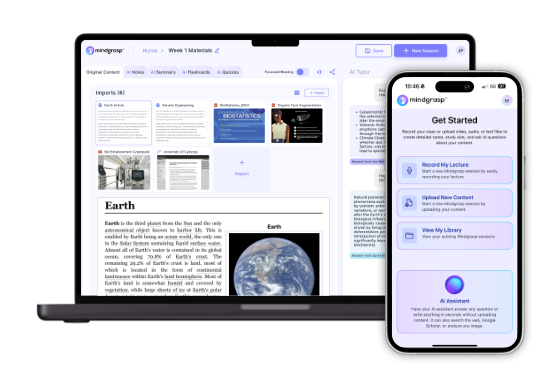
To cram for a business exam effectively, we need to prioritize high-value topics first.
Start by reviewing syllabi and past exams, then create a mini-schedule with focused study blocks. Don't just re-read notes—use active recall with flashcards and self-quizzing instead.
Break down complex concepts into visual diagrams and practice with exam questions under timed conditions. Remember to take short breaks and get enough sleep.
The right strategy turns last-minute studying into real learning.
Why cramming for business feels harder than other classes
While you might ace a history exam with late-night flashcards or breeze through biology with some quick memorization, business exams play by different rules.
We've all been there—frantically trying to absorb complex business concepts the night before, only to feel like nothing's sticking!
Business cramming feels harder because:
- These exams test understanding, not just facts—you need to apply theories to real-world situations
- The material is deeply interconnected—marketing affects finance affects management (you get the picture)
- Your strengths and weaknesses matter more—analytical thinking can't be memorized overnight
Effective study tips start with smart time management. Break your cramming into concept chunks rather than trying to memorize everything.
Boost Your GPA Faster with Mindgrasp
Instantly turn your class notes into smart summaries, flashcards, and quizzes—study less, learn more, and ace your exams.
Try it FreeStep 1: Determine what to study (Prioritize high-impact topics)
Facing the mountain of material for your business exam can feel overwhelming, but let's tackle it strategically!
First, check your syllabus and study guides – these are goldmines for identifying what your professor thinks is important.
Look at past practice exams to spot the high-impact topics that appear frequently. These recurring themes aren't coincidental – they're your ticket to a better grade!
When creating your study schedule, allocate more time to:
- Topics with the highest point values (financial management, marketing strategies)
- Concepts your instructor emphasized in class
- Areas where you're less confident
Step 2: Gather your business materials and make a quick plan
The success of your business exam cramming depends heavily on having all your materials organized and ready to go. We recommend collecting everything you'll need—textbooks, class notes, handouts, and past exams—before you start studying. This prevents time-wasting searches for that missing chapter later!
Next, create a quick study plan that works with your remaining time. Look at your exam preparation realistically—if you've only got 8 hours, divide them wisely across topics, giving more time to areas where you're shakier.
Break your sessions into 25-minute chunks (like the Pomodoro technique) with short breaks in between.
Don't forget to prioritize your study materials based on what your professor emphasized in class—these points are usually exam goldmines!
Step 3: Use active recall to study business (Don’t just re-read)
• Create quick flashcards with key business terms and definitions – then test yourself repeatedly.
-
Try self-quizzing by writing answers to potential exam questions without peeking at your notes.
-
Summarize important concepts from memory, then check for accuracy.
-
Form a quick study group where you can quiz each other on tough concepts.
Why does this work? Active recall strengthens memory pathways much better than passive reading.
Your brain remembers what it has to work for – so make it work!
Step 4: Break down complex business processes with diagrams
Business processes can feel overwhelming when you're cramming for an exam. That's where diagrams become your best friend!
We've found that visual representations can transform those confusing multi-step processes into something you can actually understand.
Try these approaches:
- Create flowcharts to map out sequential steps and decision points
- Use swimlane diagrams to clarify which departments handle specific responsibilities
- Draw mind maps to connect related concepts and see the bigger picture
When you're deep in study mode, converting text-heavy notes into diagrams helps your brain process and retain information faster.
Plus, these visuals make for perfect quick-reference tools when you're reviewing right before the exam. Remember - a single diagram can replace pages of notes!
Step 5: Leverage AI study tools like Mindgrasp AI for business
When cramming becomes overwhelming, smart students turn to AI-powered study tools like Mindgrasp AI to supercharge their business exam prep.
We've found that these tools are game-changers for last-minute studying!
Try Mindgrasp for Free!
Experience an easier, faster way to boost your GPA. Sign up now to try Mindgrasp AI for free and see how AI-powered learning transforms your study routine.
Try it FreeWith Mindgrasp AI, you can:
- Upload your business notes and get instant summaries of complex concepts
- Create custom flashcards tailored to your specific course material
- Practice active recall through AI-generated questions
What's really cool is how it analyzes past exams to help you focus on topics that frequently appear.
No more wasting time on unlikely material! Instead, you'll develop a personalized study plan that maximizes your limited cramming time.
The tool fundamentally does the heavy lifting, so you can concentrate on actually understanding the business concepts that matter most.
Step 6: Memorize key terms and definitions with flashcards & mnemonics
Mastering business terminology forms the backbone of exam success, and flashcards are your secret weapon for rapid memorization!
We recommend creating simple cards with key terms on one side and concise definitions on the other. Quiz yourself regularly to identify which concepts need more attention.
Don't just memorize blindly – group related terms together to build meaningful connections between concepts. Try using mnemonics (those clever acronyms or phrases) to simplify complex ideas. For example, the 4Ps of marketing become "Please Protect My Cat" (Product, Price, Promotion, Place).
Color-coding your flashcards can also work wonders – maybe blue for finance terms and green for management concepts? Your visual memory will thank you when you're recalling definitions under pressure!
Step 7: Practice with questions and problems
Now that you've built your vocabulary arsenal with flashcards, it's time to put that knowledge into action! Practicing with past exam questions is honestly the best way to prepare for your business exam.
We recommend tackling at least three years' worth of past papers under timed conditions – this helps you get comfortable with the exam format while improving your time management skills.
Mix up your practice with different question types (multiple-choice, case studies, short answers) to cover all bases.
Don't just answer questions – analyze them! Look for patterns in what you're getting wrong and focus your remaining study time there.
Why not form a study group? Taking turns quizzing each other reinforces your learning and catches blind spots you might've missed on your own.
Step 8: Take short breaks and look after yourself
Despite what you might think, cramming doesn't mean studying non-stop until your brain turns to mush! When preparing for your Business Studies exam, taking regular breaks is actually going to help you learn better.
Try the Pomodoro technique – study for 25-30 minutes, then take a 5-minute break.
During these breaks:
- Stretch or take a quick walk (gets your blood flowing!)
- Practice deep breathing or a mini-meditation (calms exam anxiety)
- Stay hydrated and munch on brain foods like nuts or fruit
- Stand up and move around (no more zombie posture!)
Cramming for business in 1 Day, 3 Days, or 1 Week
We've all been there — staring at a calendar and realizing our business exam is approaching fast.
If you have a week, you can create a structured study plan tackling different topics each day, while three days calls for more focused priorities and practice tests.
With just 24 hours left, don't panic — concentrate on memorizing key terms, reviewing the most heavily weighted concepts, and getting enough sleep to keep your brain sharp on exam day.
Cramming for business with one week left
When you've got a full week before your business exam, you're actually in a pretty good spot! With seven days to work with, we can create a smart plan that won't leave you panicking.
Start by mapping out a focused study schedule that divides the material into daily chunks. Make sure you cover all the important stuff—like financial management and marketing principles—since these typically carry more weight on exams.
Don't just read your notes! Test yourself regularly using flashcards or practice questions to boost your memory.
Try working through past exams under timed conditions to get comfortable with the format.
Remember to take breaks (we love the Pomodoro technique—25 minutes of study followed by a 5-minute break). This keeps your brain fresh and helps you avoid that dreaded burnout!
Cramming for business with three days left
Three days before your business exam might feel like crunch time, but it's actually enough to get a solid review if you're strategic! Let's make the most of this time.
First, focus on high-value topics—administration and accounting make up over 50% of most business exams. Don't waste time on minor sections!
Create a mini-schedule that breaks down each day:
- Morning: Study core concepts
- Afternoon: Practice exam questions
- Evening: Review weak areas
Test yourself constantly—flashcards and quick quizzes work wonders for last-minute retention.
And don't forget to practice with past papers to get comfortable with the question style.
Remember to take hourly breaks (just 5-10 minutes) to keep your brain fresh. A tired mind won't absorb anything!
Cramming for business with one day left (24 hours)
So you've got just 24 hours before your business exam—don't panic!
It's time to be super strategic with your limited time. Focus exclusively on high-value topics (especially administration and finance) that appear most frequently on exams.
Create simple flashcards for key definitions and review them during bathroom breaks, meals, or while walking to class.
Take one practice exam under timed conditions to simulate tomorrow's pressure. Don't waste time on concepts you already understand—target your weak spots!
Break your day into focused 25-minute sessions with 5-minute breaks to prevent burnout.
Before bed, quickly scan past exam papers to familiarize yourself with question patterns.
Common mistakes to avoid when cramming and how to fix them
Despite our best intentions, many of us fall into predictable traps when we're cramming for business exams. The biggest mistake? Waiting until the night before to start studying. Instead, give yourself at least a few days to let the material sink in.
Don't get lost in minor details while missing the big picture concepts that professors love to test.
And remember — marathon study sessions don't work! Break your cramming into 25-50 minute chunks with short breaks in between.
Many students skip practice questions (big mistake!). Set aside time to work through sample problems so you'll recognize similar patterns on test day.
Finally, don't sacrifice sleep or proper meals. Your brain needs fuel and rest to perform well — no amount of caffeine can replace them!
Final Takeaways on business cram studying
While avoiding those cramming pitfalls can save you from disaster, let's focus on what actually works when you're down to the wire with a business exam.
We've found that summarizing key concepts from each chapter gives you the biggest bang for your buck. Don't just re-read—quiz yourself with flashcards to cement that information in your brain!
Remember to be strategic about your limited time:
- Focus on high-value topics first (check your syllabus for point values)
- Use the Pomodoro technique—25 minutes of focus, then a quick break
- Create simple outlines you can review right before the exam
When time's tight, it's not about learning everything—it's about learning the right things effectively.
You've got this!
Download Mindgrasp from the App Store
Access Mindgrasp at your desk for in-depth research and writing projects, or use the mobile version to easily access your content on-the-go or record live lectures.
Download the iOS App
